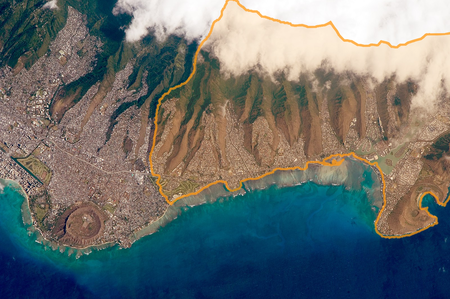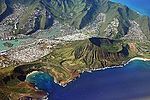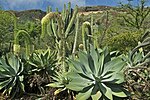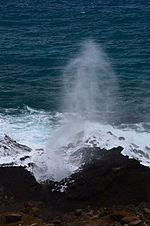Maunalua Bay is a bay in the southeast of Honolulu, the capital of Hawaiʻi. The bay extends about 6.3 miles (10.1 kilometers) from the southern tip of Diamond Head, the Black Point, also called Kūpikipikiʻō , in the west to Portlock Point, also known as Kawaihoa Point, to the east.
On the land side, just to the east of Diamond Head is the upmarket suburb of Kāhala. Following are several affluent hillside suburbs like Hawaii Loa Ridge, a gated community that occupies an entire slope. In the east is the suburb of Hawaii Kai, built by industrialist Henry J. Kaiser after World War II. Hawaii Kai has a marina, shopping centers, including a Costco, Walgreens, Longs, and Safeway, and numerous restaurants such as the well-known Roy's and Kona Brewing Co. pub. On the headland leading to Koko Head is the suburb of Portlock, which is a part of Hawaii Kai.
The name Maunalua (from Mauna = mountain and [ʻe]lua = two, in the native Hawaiian language) refers to the designation of the area what is now referred to as "Hawaii Kai." The mountains, located inland from Portlock Point, are the 645 feet (197 meters) high Koko Head, and about 2.2 miles (3.5 kilometers) east thereof, close to Hanauma Bay the Koko Crater, the walls of which rise up to 1,207 feet (368 meters).
According to one legend, Maunalua was one of the first settlements when settlers arrived in Hawaiʻi around the 12th century. Native Hawaiians originally lived there by fishing and cultivating sweet potatoes (ʻuala) along the coastal plains at a place called Ke-kula-O Kamauwai. Maunalua was formerly famous for having the largest Native Hawaiian fishpond (loko iʻa) on Oʻahu. The 523 acre fishpond known as Keahupua-O-Maunalua had a wall or kuapā which originally spanned from Kuliʻouʻou headland and to what is now Portlock. The pond was used primarily to raise mullet (ʻanae) and was also home to a multitude of endemic or indigenous waterbirds. The area continued to be important for fishing and agriculture until the 1950s when the fishpond was filled for housing development.








